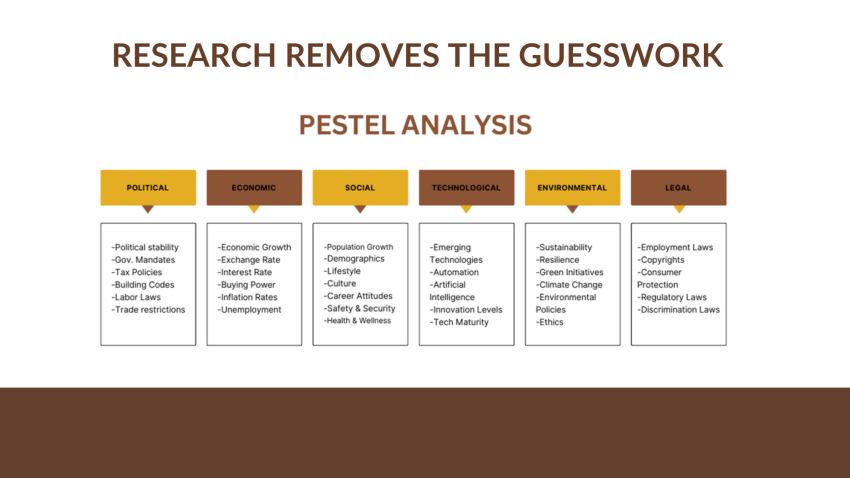Research Makes Marketing Easier (And Smarter)
Let’s face it. Figuring out how to market your services isn’t always easy. But here’s the good news: research takes a lot of the guesswork out of the equation, especially in the AEC (Architecture, Engineering, and Construction) industry. Having the right information can help you craft a clear, realistic marketing plan that actually works. When you understand what’s happening around you, and within your own firm, you’re in a much better place to make smart, confident decisions.
Whether your goal is to land more of the right kind of work, improve your marketing strategy, or stand out from the competition, research gives you the clarity you need to move forward with purpose.
Why Bother with Research?
It’s simple: you can’t prepare for challenges you don’t know exist. Research helps you uncover the obstacles and opportunities ahead so you can spend less time spinning your wheels and more time chasing work you’re truly qualified for. You’ll be better equipped to enter markets with real growth potential and avoid those that just aren’t worth your time.
It also helps you understand your clients better. Once you know what they care about and what problems they’re facing, you can position your firm as the solution, while building stronger, long-lasting relationships as a result.
Start With the Big Picture
Before you dive into the details, it helps to look at the broader forces that affect your business. A PESTEL analysis is a great place to start. It assesses Political, Economic, Social, Technological, Environmental, and Legal factors that might impact your firm.
These days, the economic landscape is throwing curveballs left and right: rising interest rates, material costs, labor shortages, you name it. At the same time, social trends like the push for better quality of life and sustainability are changing how clients think and what they expect. Understanding these trends helps you stay ahead of the curve and make decisions based on facts, not assumptions.
Don’t Forget to Look Inward: The SWOT Check
Once you’ve looked at the outside world, it’s time to turn inward with a SWOT analysis. That’s where you identify your firm’s Strengths, Weaknesses, Opportunities, and Threats.
You’ve got to know where you are before you figure out where you’re going. Take a good, honest look at your market sectors, your revenue sources, your best clients, and your bread-and-butter services. Be clear on your strengths and weaknesses. No sugarcoating.
Then look outward: What are your competitors doing? What are they doing well that you’re not? What’s setting them apart? Understanding this will help you figure out what needs to change to get ahead.
One more thing: think about where your services are in their lifecycle. Are they just taking off? Hitting their stride? Slowing down? Knowing this will help you plan strategically and go after work your firm is well positioned to win.
Ask the Right Questions
Before you do anything else, ask yourself: What problem are we trying to solve? Are you not landing the projects you want? Struggling to gain traction in a new market? Wondering whether to expand? The research you do should help answer that question.
Once you’ve nailed down the problem, set a SMART goal (Specific, Measurable, Achievable, Relevant, and Time-bound). That’ll keep you focused and make it easier to act on what you learn.
Primary vs. Secondary Research: What’s the Difference?
There are two main types of research: primary and secondary. Primary research is stuff you collect yourself in the form of interviews, surveys, or focus groups. It’s custom, relevant, and completely yours. The tradeoff? It takes more time and money.
Secondary research is already out there. Whether it’s industry reports, databases, articles, or even social media posts. If its public, it’s fair game. It’s faster and cheaper, but you have less control over the content and quality. Ideally, you want a mix of both.
Quantitative vs. Qualitative: Know Your Style
Some people love numbers. Others love stories. I love both, which is good for me because good research includes both. Quantitative research gives you hard data like percentages, rankings, and stats. Qualitative research dives into the “why” behind the numbers like what people are thinking and feeling when they make decisions.
Together, they give you a more complete picture. That’s especially helpful when you’re trying to understand client behavior or predict future trends.
Bringing it all Together
Marketing doesn’t have to be a guessing game. With the right research, you can approach your strategy with clarity and confidence. It helps you uncover what your clients really want, what your competitors are up to, and where your firm stands in the big picture. Most importantly, it gives you the tools to make smart, informed decisions that move your business forward.
No matter the size of your firm or your role in it, research empowers you to be more strategic, proactive, and prepared. You don’t have to do it all at once. Taking small, consistent steps toward building a research-informed marketing plan can make a big difference.
So, take a deep breath, ask the right questions, and start where you are. Your future marketing success begins with knowing more today.

